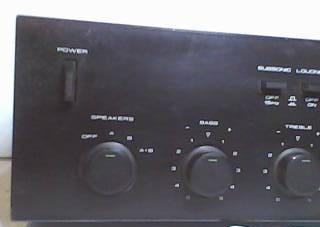This article was written on Wednesday, July 16, 2014
Just got hold of this old amplifier at an action for some few coins. At least something not counterfeit or generic for a small price. The intentions were to get it fixed and sell it. I didn’t sell it! I still have the amplifier 5 years later.
The first thing I did was not to power it because this pioneer SA-930 amp was an American model which used 120 Volts instead of the unsteady 240 Volts currently supplied at a very high cost by Kenya Power and Lighting Company. Also there was no way I would fit that American style plug into my British Standard socket outlet.
After opening this baby up I was shocked to find out a number of things. First that I was the first person to actually open this bad boy up ( that’s a talent right there) and secondly that I assumed that the fuse had blown this I did in just the first 30 sec of lifting the lid (like I told you before talent).
My theory so far, some guy came with this amp to Kenya from the US and what I could tell so far is that he and the previous owner really knew how to take care of their stuff because this bad boy didn’t have a single dent. Secondly that the previous owner tried to power it up on a Kenyan 240V supply and just blew the fuse and that he defaulted on a loan and that’s how I came to own the amp via auction.

I also noticed that the Transformer in use was a centre tap transformer, not only in the secondary side but also on the primary side too. So if the transformer uses 120 Volts from the centre tap position, then it should function well with 240 Volts across the end terminals, right? I tried to connect the Transformer to 240 volts directly to the two end primary terminals, it worked but the transformer vibrations were too much, not to mention the overheating power cables. I have never experienced overheating cables from a low voltage supply load before.
Back to diagnosis and fixing, all I did was just replace the fuse and buy an 110v to 220v transformer and now this bad boy is churning music like no ones business as I am writing this column I’m bouncing my head to that some dancehall tunes. To power the amplifier I used a universal power extension that can “accept the American style plug.
This is the transformer I bought in 2014. I still use it today. Infact I used it to repair an Onkyo AV receiver. Watch the Onkyo video here. I have the video embeded at the end of this article too.

The amp is in good shape and all the knobs and volume slider are functioning well. With a press of the button labeled Loudness, the bass volume becomes louder. The Output level LEDs are functioning well; they light up according to the beat of the music as well as the volume level selected. The LED lights are also for separate channels i.e. R and L so if you change the balance settings in favour of one channel, the evidence will show on the LED disco lights.
I have not yet tested the phone jack, who uses those big phone jack for headphones nowadays? I am thinking of making an external connector that will eventually lead to a 3.5mm headphone jack.

The Audio input jacks at the back function well but the Microphone jack is more sensitive because of the lack of a pre amplifier on all passive microphones. When I used normal PC audio feed in to the Microphone jack the sound was louder and any attempt to increase the volume led to distortion.
The amplifier also has a relay that connects the Transistor outputs to the speaker ports. The relay click (turns ON) after around 30 seconds of powering the Amplifier. The relay is there so that it disconnects the speakers immediately the supply id turned off. This in turn prevents the Amplifier from “talking” when the supply is disconnected because of the Electric charge that still remains in the big 56Volts 8600uF capacitors.
And now some specifications this amp has:-
Continuous average power output is 70 watts per channel minimum at 8ohms
It’s a stereo amp with 2 speaker ports for each side R & L so that’s a total of 280 watts. This amplifier is loud and has some pretty quality music for its age. The speaker ports for each channel have been spliced into A and B. With the turn of the Knob Speakers at the front you can select the speaker modes as follows, OFF, A, B, and A+B.
The downside is that the Pioneer SA 930 Amplifier has many open vented ports at the top, this makes dust collection very easy and fast and should I mention the possibility of spilling some soda in to the Amp. Any way the Amp was not made for children who drink soda but for music lovers who take care of their equipment.

